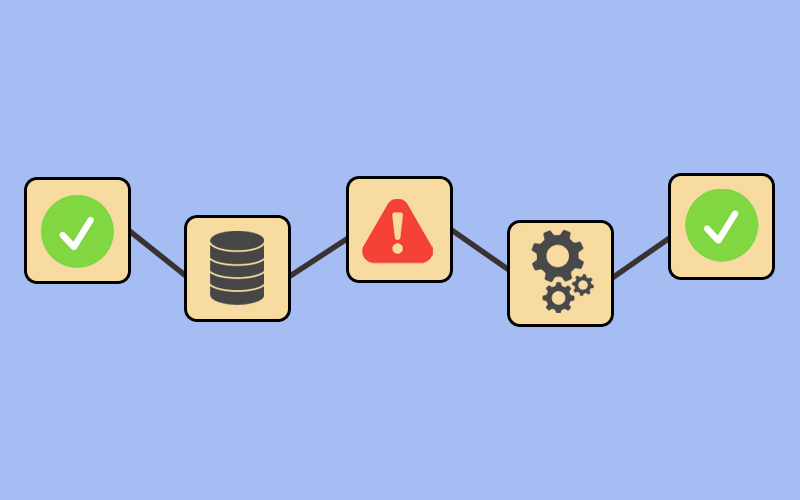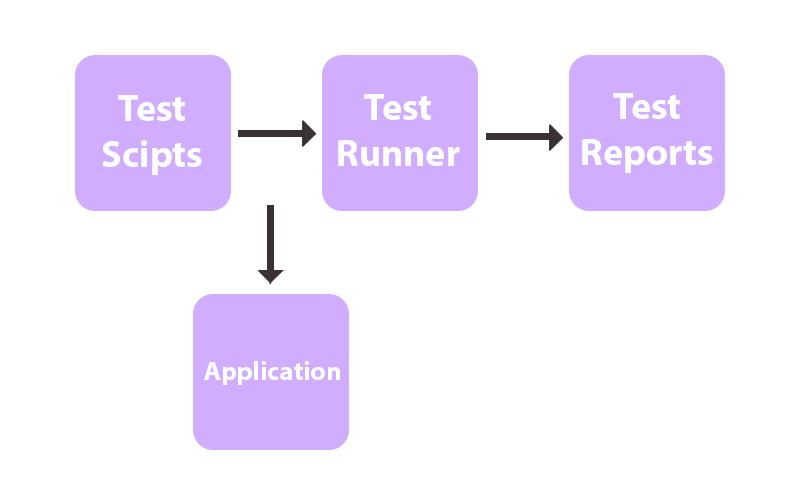

What Is End To End Testing?
End-to-end testing, or E2E testing for short, is a method of careful testing by software checking the whole process of application, from start to finish. This technique simulates realistic user cases and uses actual data to test the smooth operation of all parts and guarantee the soft app works perfectly in real-life conditions.
Suppose we want to test an e-commerce website thoroughly. We would go through the whole buying process, from choosing a product, putting items in the cart, filling in payment information, placing the order, and getting an email with approval. Also, checking of various website parts is also needed on how they work well together, such as a cart, payments, and email notifications.
End to end testing is essential as it can detect probable mistakes that might occur during the integration of all components. Such a method facilitates ensuring the dependability and quality of a system before it is deployed, making it more resilient. Furthermore, it reveals how the application performs from an end user’s viewpoint, resulting in a thorough assessment of the software’s quality.
What Is End-To-End Testing In Soft Checking?
End to end tests are very important in any testing of the soft as they cover the whole application, emulating real-life prognosis of a user with actual data. E2E testing guarantees proper work of application and satisfaction of user needs.
This stage is the last one in the testing of software. During it, all elements of a code and all soft characteristics are tested as an entire system. It tests the obvious behavior of components and ensures the correct work of the soft app in conditions of reality.
End-to-end tests play a crucial role in identifying potential errors that may arise during the integration of all components. This guarantees the system’s stability and establishes quality standards before deployment. Additionally, it provides insights into the application’s performance from the end user’s perspective, offering a comprehensive evaluation of the full quality of a soft.
Examples of End 2 End Testing
End to end solution is a holistic way of software testing that covers the verification of the whole soft system, as well as its connection with external interfaces. By mimicking situations in the real world, it ensures the dependability of the system by finding and fixing probable problems or errors before deployment.Here you can estimate certain end-to-end testing with an example:
- E-commerce website testing: Simulating user order placement, payment processing, and verifying order fulfillment and delivery.
- Testing of Voice recording app: Simulating user audio recording, downloading the file, and integrating it with email to send recorded audio.
- Gmail testing: Simulating user interaction, including login, composing and sending an email, verifying successful delivery, and logout.
Application
E-commerce website
Voice recording app
Gmail
Test Scenario
Order placement and delivery
Audio recording and sharing
Email sending and receiving
Test Steps
- Simulate a user’s order placement
- Simulate payment processing
- Verify the correct fulfillment and delivery of the order
- Simulate a user’s audio recording ranging from one second to five minutes
- Download the audio file to the phone
- Integrate with an email app to send the recorded audio files
- Launch a browser
- Log in with valid credentials
- Compose and send an email
- Verify successful delivery to the recipient
- Log out from the app
How End To End Testing Differs From Integration Tests?
Integration tests and E2E differ from each other completely, but both check the comprehensive operation of all system components. E2E testing focuses on the entire application, based on the experience of a user, but integration tests are aimed at checking some components as a unit and focus on the way of their communication with foreign systems.
End-to-end testing as a rule is performed when the development process is finished, when integration tests start at the beginning of testing. One and another test are important in making sure complex systems are dependable and robust.
Here’s a comparison table to estimate end to end testing vs integration testing:
Scope
Objective
Testing Focus
Test Environment
Coverage of testing
Timing
Dependencies
Test Data
Defect Identification
Importance
Involvement
End-to-End Testing
Validates the entire soft system
Properly ensures functions of a system in real-life prognoses
Simulates scenarios and flows of a user in real-world conditions
Replicates real-world conditions and external interfaces
Covers well the whole application flow
Conducted towards the later stages of cycle of the soft development
Requires fully developed and integrated soft system
Uses realistic and representative data
Identifies issues across the entire system
Detects system-level issues, and guarantees overall system stability
Involves multiple teams and stakeholders
Integration Testing
Verifies the relationship between particular modules
Validates the different modules/components integration
Concentrates on module-to-module interactions
Focuses on the interaction of limited components
Specific coverage of module interactions
It can be made during the whole process if development
It is possible to conduct them on individual modules in isolation
May involve test data specific to module integration
Identifies issues related to module interactions
Verifies module interactions and interface correctness
Typically involves developers and testers
How integration testing essentially differs from end-to-end solutions:
Focus: Integration tests ensure the functionality of components personally and together, but E2E testing evaluates the whole product from the user’s point of view.
Scope: Integration tests are narrower, targeting specific functionalities or modules with dependencies, while end to end testing is broader, encompassing user processes and prognoses spanning multiple properties or modules.
Environment: It is possible to make integration tests in a simulated or isolated environment, whereas End 2 End tests necessitate a fully functional environment closely resembling the real operational setup.
Speed: Integration tests are usually faster since it involves fewer parts and steps of the process, while end-to-end testing takes longer due to the inclusion of numerous steps, components, and possibly external factors.
Maintenance: Integration tests are easier in maintaining as they are less influenced by design or user interface changes, whereas E2E may require more frequent updates due to its sensitivity to UI or design changes.
How Is End To End Test Framework Organized?
E2E testing is a complex of software test methods checking the functional and application data flow, covering all subsidiary systems connected to each other from the beginning to the end. It simulates the user’s journey through the app, verifying the seamless operation of built-in components, dependencies, and elements connected to each other.
A wide range of frameworks for end-to-end testing is available and adopted by different technologies and platforms. Some notable examples of major end to end testing frameworks are as follows:
- Protractor
- NightwatchJS
- Cucumber
- Cypress
- Selenium
- WebdriverJS
- Testim
- testRigor
- WebdriverIO
The purpose of these frameworks is to ensure a structured framework of automation tests, ensuring the reliability and manageability of the created tests.
A standard block diagram of an end to end testing framework is depicted below:

How End To End Testing Plan Can Be Created?
The testing process follows a thorough document called a plan of e2e testing. This document specifies a subject, a reason, a method, and a time to test. It includes information about the team, the tools, the test cases, the test data, the test environment, the performance, the control of defects, and the reporting. It facilitates the organization of the testing process, assigning of roles, and setting up of the required environment.
To perform comprehensive end-to-end testing plan the following steps are required:
– Make an analysis of the requirements to understand the working principle of application in all aspects.
– Set up a testing environment that corresponds to the requirements and possesses all necessary parts of software and hardware.
– List all primary and secondary systems of the app, and describe their interaction process.
– Write down the expected outcomes and responses for each system and subsystem.
– Choose the testing methods and tools that can best verify these results and responses.
– Make testing cases covering a variety of users, which guarantees complete coverage.
– Run testing cases, check results, and report any defects or issues quickly.
– Repeat the end to end process, with necessary fixes till all defects are recovered, and the app corresponds to the standards of quality.
Main End To End Solutions
End-to-end testing finds tools and frameworks dedicated to the automation and performance of comprehensive tests for software apps. Such tests, known as end to end tests, assess the functionality and an application execution in its whole workflow in conditions of the real world. They imitate the journeys of users and check the entire system’s behavior, including its sub-systems and dependencies.
We would like to provide some notable end-to-end solutions:
- Autify: A cloud-based platform that facilitates cross-platform testing across diverse devices and operating systems.
- BugBug: A tool based on a browser enabling agile teams to create, edit, and make automatic testing that does not contain coding, with executing a function of end to end testing automation
- Head spin: The platform offers secure scaling of testing work and provides an understanding of the performance, quality, and experience of users.
- Nightwatch: A flexible framework supporting custom commands, assertions, and plugin implementation.
- Mabl: A tool utilizing AI to automate test creation, execution, and maintenance.
- Avo Assure: This tool assists in visualizing workflows, monitors testing cases, and generates reports of tests.
- Smart Bear: A suite of tools covering various testing aspects such as tests of API, UI tests, performance tests, and test
- TestRigor: The tool enables the creation of robust and stable end-to-end tests using plain English.
- Selenium: A widely adopted open-source framework supporting multiple browsers, scripts, and platforms.
- Cypress: The framework based on JavaScript simplifies web application testing by operating directly in the browser.
These end-to-end testing methods ensure distinct characteristics, pros, and cons, allowing software projects to choose based on their certain needs and requirements.
About End To End Testing Best Practices
The best practices of End2end testing are guides or recommendations aimed at ensuring the efficiency of end-to-end tests. These testing methods can estimate the functionality and full performance of an app, and able to replicate conditions of a real-world and validate the behavior of the whole system as well as its secondary systems and dependencies.
We would like to provide you with the key end to end testing best practices:
- Make testing of the full user journey: Cover all possible paths and scenarios that users may encounter, not just the most popular working process of your app.
- Use certain and realistic data: Use data that reflects the actual data users will enter or interact with, including invalid, incomplete, or malicious data.
- Test edge cases: Assess less likely but impactful situations such as unexpected inputs, network failures, timeouts, or exceptions.
- Use various environments in performing tests: Check your app in different browsers, devices, operating systems, and networks used by your users.
- Automate tests: Leverage test automation tools and frameworks to create, execute, and support end-to-end tests, making their execution faster, ensuring broader coverage, and continuousness of testing.
- Document testing cases: Precisely and consistently document test cases using a standard format and language to communicate objectives, steps, expected results, and current results to parties concerned.
- Constantly test: Perform e2e tests regularly, especially after any application changes or during its updating, for detecting and addressing bugs or regressions early.
Provided these best practices are followed, you can enhance this end-to-end process, ensuring satisfaction with your app user’s demands. Implementing these guidelines contributes to delivering a high-quality software product.
